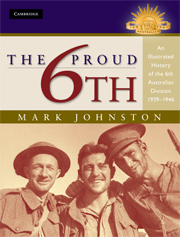Book contents
- Frontmatter
- Epigraph
- Contents
- List of Maps
- Acknowledgements
- Conventions and Abbreviations
- Introduction
- 1 Origins and Early Days
- 2 Bardia
- 3 Tobruk to Benghazi
- 4 Greece
- 5 Crete
- 6 Syria
- 7 Return to Australia
- 8 Kokoda to the Sea
- 9 Wau-Salamaua
- 10 The Longest Wait: Australia 1943–4
- 11 Aitape–Wewak
- 12 Conclusion
- Appendix 1 6th Division Casualties
- Appendix 2 6th Division Honours and Awards
- Notes
- Bibliography
- Index
10 - The Longest Wait: Australia 1943–4
Published online by Cambridge University Press: 05 February 2015
- Frontmatter
- Epigraph
- Contents
- List of Maps
- Acknowledgements
- Conventions and Abbreviations
- Introduction
- 1 Origins and Early Days
- 2 Bardia
- 3 Tobruk to Benghazi
- 4 Greece
- 5 Crete
- 6 Syria
- 7 Return to Australia
- 8 Kokoda to the Sea
- 9 Wau-Salamaua
- 10 The Longest Wait: Australia 1943–4
- 11 Aitape–Wewak
- 12 Conclusion
- Appendix 1 6th Division Casualties
- Appendix 2 6th Division Honours and Awards
- Notes
- Bibliography
- Index
Summary
All three AIF infantry divisions experienced a long, dull, trying hiatus before the final campaigns, but the 6th Division waited longest. One brigade, the 19th, waited three and a half years. The shortest break, for the 17th, was more than a year. Frustration and disappointment resound through the contemporary writings and memoirs of all who endured 1943 and 1944 in camps in Queensland's Atherton Tableland.
Between July and September 1943 the 16th and 19th Brigades believed they were about to move to New Guinea, and indeed while undertaking amphibious training were warned to prepare for movement overseas. However, in late September the divisions already in New Guinea were making such progress that the move was deferred. There were some diversions in the way of sport and, from mid-1944, a 6th Division Other Ranks’ Club, the ‘Kangaroo Club’ was established and well patronised in the Wondecla area, where the division was based. However, in their none-too-salubrious camps, 6th Division men tended to feel isolated and neglected by the civilian community. One's own family circle was of course an exception, and men still hankered after personal leave.
Public parades also brought attention. On 18 November 1943, the 17th Brigade marched past huge crowds in Melbourne, which endorsed the message shown on the banner in Photograph 10.1: ‘Well Done the 17th’. This march signalled the end of the brigade's leave. Photograph 10.2 symbolises what the soldiers left behind when they went back to camp, as here a beautiful blonde attaches herself to one of the marching men. Naturally the presence of wives, girlfriends and other loved ones made leave the most enjoyable feature of this period for 6th Division members.
- Type
- Chapter
- Information
- The Proud 6thAn Illustrated History of the 6th Australian Division 1939–1946, pp. 182 - 191Publisher: Cambridge University PressPrint publication year: 2008

